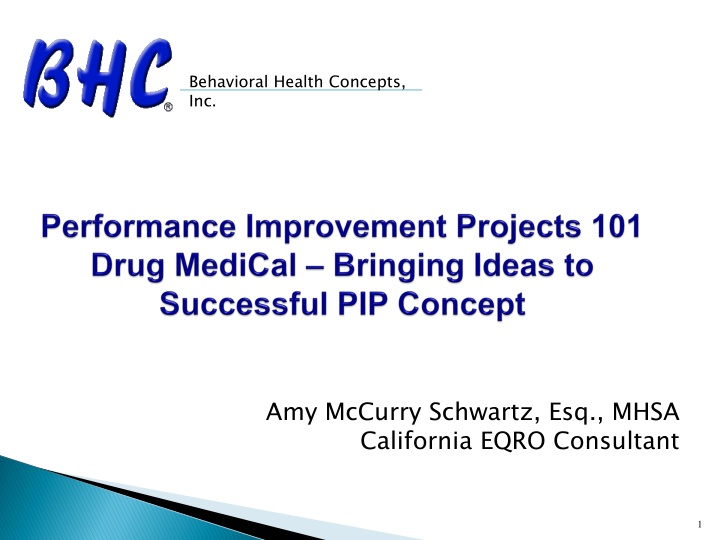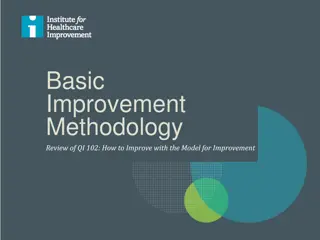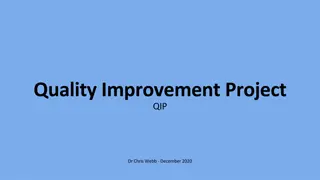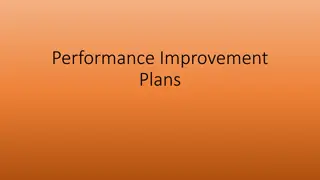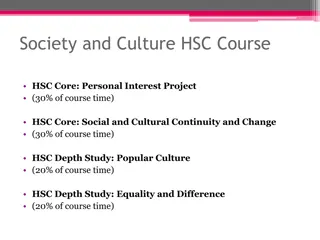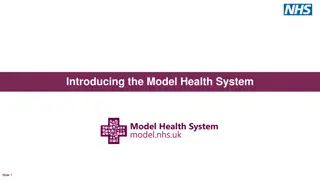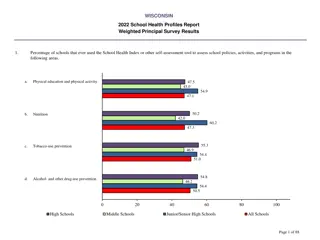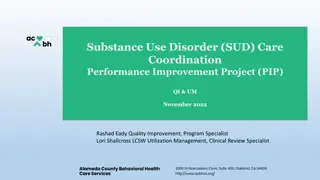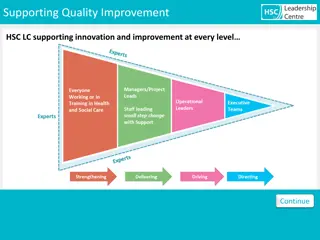Insights into Performance Improvement Projects (PIPs) for Health Programs
Delve into the differences between PIPs and Performance Measures, the importance of Clinical vs. Non-Clinical PIPs, and the OMB approval for EQR Protocol. Understand the protocol validation activities for quality reviews.
Download Presentation

Please find below an Image/Link to download the presentation.
The content on the website is provided AS IS for your information and personal use only. It may not be sold, licensed, or shared on other websites without obtaining consent from the author.If you encounter any issues during the download, it is possible that the publisher has removed the file from their server.
You are allowed to download the files provided on this website for personal or commercial use, subject to the condition that they are used lawfully. All files are the property of their respective owners.
The content on the website is provided AS IS for your information and personal use only. It may not be sold, licensed, or shared on other websites without obtaining consent from the author.
E N D
Presentation Transcript
Behavioral Health Concepts, Inc. Amy McCurry Schwartz, Esq., MHSA California EQRO Consultant 1
The purpose of PIPs To assess and improve processes, and thereby outcomes, of the substance use disorder continuum of care. How is a PIP different from a PM (Performance Measure)? A PIP focuses on program improvement, a PM reflects current performance of an measure. 2
Clinical vs. Non-Clinical PIPs The requirement for DMC programs to do both clinical and non-clinical PIPs comes from the federal regulatory definition of a PIP. 42 CFR 438.240(d) defines PIPs as having a focus on clinical and non-clinical areas. 3
Clinical PIPs Might Target Prevention and care of acute and chronic SUD conditions including relapse High-volumes of services such as 180 days or more of residential in a year High-risk procedures detox w/mixed drugs Reducing clients leaving residential detox and not continuing treatment 4
Non-Clinical PIPs Might Target Coordination of Care across SUD continuum and other treatment or support resources Appeals, Grievances Processes Timely Access to Assessment & Treatment Client Services and experience of care 5
OMB Approval No. 0938-0786 EQR PROTOCOL 3: VALIDATING PERFORMANCE IMPROVEMENT PROJECTS (PIPs) A Mandatory Protocol for External Quality Reviews (EQR) by the Federal Government for all managed care plans EQR PROTOCOL 3: VALIDATING PERFORMANCE IMPROVEMENT PROJECTS (PIPs) 6
10 Protocol Validation Activities each with important steps and processes: Identify a potential the study topic(s) Define the study question(s) Use a Representative and Generalizable study population Select the study variable(s) If sampling used, valid approach (not recommended without sophisticated stat capacity) just use one site or program 1) 2) 3) 4) 5) 7
10 Protocol Steps Continued: Reliably collect data Analyze data and interpret study results Implement intervention/improvement strategies Plan for real improvement 10) Achieve sustained improvement 6) 7) 8) 9) 8
Look for topics that: Impact a significant portion of clients Get client input, data on topic/approach whenever possible Have a potentially significant impact on client SUD recovery, functional status or satisfaction Consider high-volume or high-risk conditions of the population served 9
Data sources that may help: MediCal eligibility database DMC encounter/claims data DMC performance on standardized measures on CalOMS by program External data Medicaid FFS, other health plans, local or national public health reports, research review of improvement efforts in this area (be sure to show this data has a direct correlation to the DMC-ODS s population) Special studies to examine your study question itself 10
Make the Question: Obvious Simple Answerable with the data and design you are considering 12
State the Question in a way that: Supports the ability to determine whether the intervention has a measurable improvement impact for a clearly defined population 13
Start small and simple (incremental approaches are easier to manage well) and then if successful you can bring to scale 14
#1 Whats the problem? Try to define the problem as systems issues, clinical or process oriented, that relate to individual clients' treatment, outcomes, or satisfaction. clients' IF the problem is No-Show rates: The MHP may see this problem as: Fiscal Efficiency Inconvenience Provider communication/partnership with client 15
Study questions are measurable and manageable issues that reflect the goal of the PIP. To assess and improve processes, and thereby outcomes, of the substance use disorder continuum of care it is important to the agency, the client, and to the provision of quality Substance Use health care services. 16
Dont write a question that asks: Will providing pre-appointment reminder calls for all assessment appointments reduce the DMC s cost of ASAM Assessment Services? OR Will providing training to all front line staff get them to enter appointments in a more timely manner into the EHR? 17
INSTEAD: Think or ASK? What is keeping clients from their appointments? What are the barriers to coming to the assessment appointments? Transportation Time off work or school during the clinic hours Childcare Remembering because it was too far from request Frame the PIP around these barriers. Provide interventions that mitigate these barriers. 18
Vague Study Question Example: An implied study question Is a mail intervention reminder adequate to improve SUD medication adherence over time? or Can we evaluate the use of appointment reminders? 19
Clearer Study Question Example: Will providing educational materials to doctors, counselors, and clients increase the number and percentage of clients who participate in a MAT (medication assisted treatment) clinic, and decrease the number and percentage of clients who use counseling services without MAT supports? 20
Clearer Study Question Example: Will reducing the number or incidents of multiple intake/assessment appointments prior to the first treatment session increase the number of clients successfully engaging in treatment? Even better if you add a factor by which to increase (i.e. 10%, 5%...) 21
This step is critical because it sets the framework for data collection and analysis of results. So take the time to develop a strong study question! Consult with your assigned EQRO staff to help refine the question and bring it to concept! 22
Each PIP must potentially represent the entire SUD Medi-Cal population to which the study indicators apply. For Example, a youth question might be studied only at one program but have potential to improve all such programs. 25
The DMC must decide whether to review data for the entire population or a single program or unit or set of that population. It is good to start small and incrementally bring to scale if the intervention works 26
Reasons to use a unit, set or single program: Limited resources are available to analyze the data The intervention(s) and data collection can be very resource intensive and you do not know yet if it is effective 27
Population Example: All DMC clients ages 0-18 years with a primary or secondary diagnosis of XXXXXXX as identified through claims data 28
A study indicator is: A quantitative or qualitative characteristic reflecting a discrete event or continuous status to be measured Used to track performance and improvement over time 30
Study Indicator tips: The study indicator should be objective and clearly defined The indicator must be measurable do you have the necessary data (or can you get it)? client input recommended on these is good and many counties have client QI advisory group. 31
Study Indicator tips: Use an existing indicator generally accepted in the SUD clinical guidelines such as ASAM or NIATX or SAMHSA or HEDIS or AHRQ, etc. Use an existing, relevant SUD best practice or guideline to develop the study indicator (s) to tracking improvements or change. 32
Study Indicators Example: Clients enrolled in SUD outpatient clinic with 4 visits within 30 days of initial assessment. Access & engagement indicator Percentage of clients who complete residential detox and transition to next level of care within 14 days of discharge. Transitions in care indicator 33
Study Indicators Example: Percentage of Methadone clients with 9 months or more of regular treatment visits (3 per week average) Percentage of current Methadone clients able to work at least 20 hours per week. Improved functioning indicator 34
Proper sampling techniques are necessary to provide valid and reliable (therefore generalizable) information on the quality of care provided. CAUTION true statistically valid sampling is difficult. At this point, consider a representative clinic or program that is small and build out unless you have statistical and data capacity. 37
Probability sampling is based on chance, it removes bias from the selection process. Examples: simple random sampling Non-probability sampling is based on choice, not chance. Example: convenience sampling systematic random sampling 38
Probability Sample: A study of how many clients received a client satisfaction survey after completion of a level of care during a specified year by randomly selecting 100 of the 1,000 of the DMC population. Non- Probability Sample: A study of the performance of an outpatient clinic by sampling all the clients that were seen in that SUD office on a specific day. 39
Data must be valid and reliable. Valid indication of accuracy The data measures what is intended to be measured. No other data is mixed in. 41
Example: Attendance may be a valid measure of engagement but not necessarily a valid measure of satisfaction with the program. Client satisfaction survey was reliable but discovered that because it wasn t anonymous (we had them sign them) and were completed the week prior to discharge, response bias could reduce their reliability. 42
Reliable indication of repeatability of collection method and source. Produces consistent results 43
Develop a data collection plan: Clearly identify data to be collected Identify data sources and how/when the baseline and repeat indicator data will be collected 45
Specify who will collect the data and that they are qualified to collect the data Data collection personnel have the conceptual and organizational skills to abstract the data. 46
Experienced clinical staff, such as SUD certified counselors, should be used to extract the appropriate data from medical records (if this is data source) to support a judgment about whether SUD clinical criteria are met. In contrast, trained assistants or medical records clerks may collect data if the abstraction involves verifying the presence of a diagnostic test or assessment report, etc. (i.e. is is present or not??) 47
